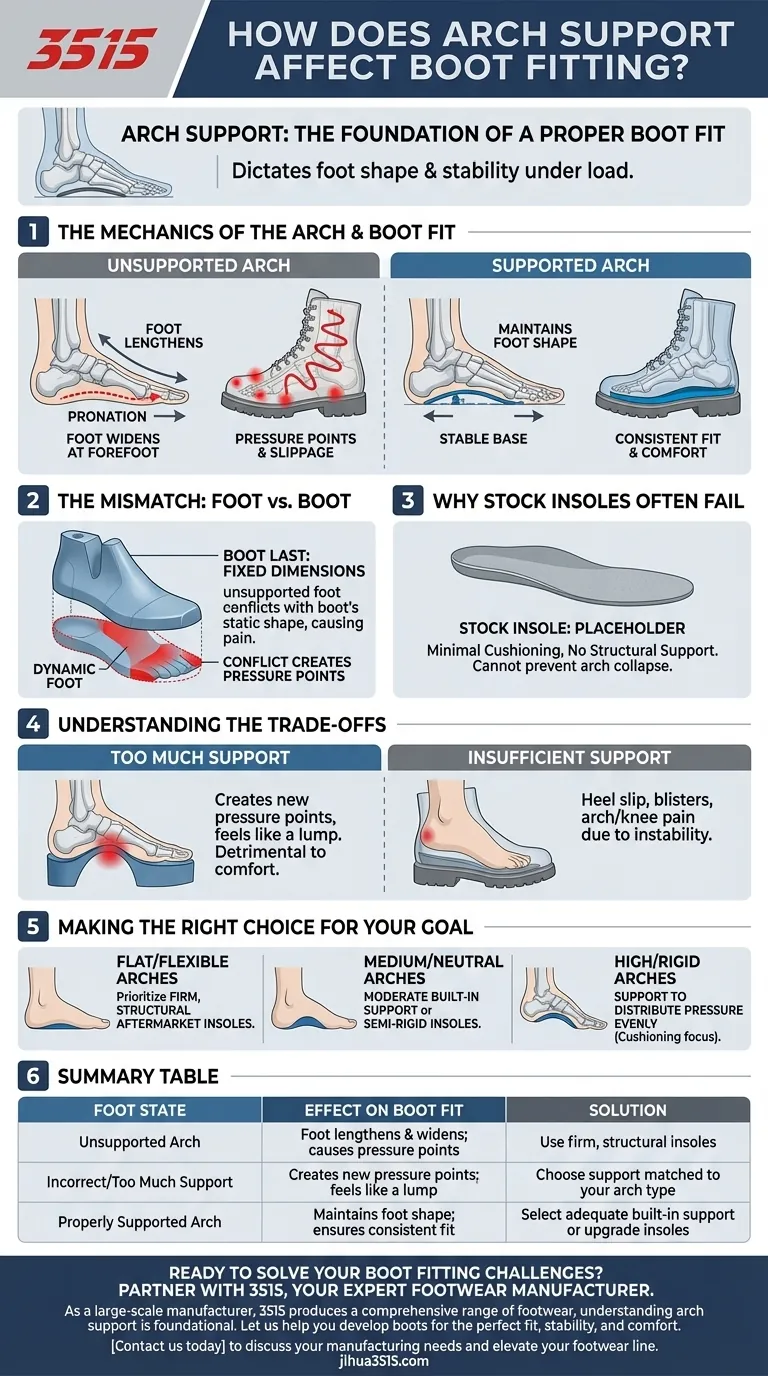Arch support is the foundation of a proper boot fit because it dictates your foot's shape and stability under load. An unsupported arch collapses when you apply weight, causing your foot to lengthen and widen. This change in shape is the primary reason a boot that feels perfect when you first try it on can become painfully tight and ill-fitting during use.
The core purpose of arch support in boot fitting is not just about comfort—it's about structural control. By stabilizing your arch, you maintain your foot's intended length and width, ensuring the boot fits consistently and preventing pressure points, slippage, and fatigue.

The Mechanics of the Arch and Boot Fit
How an Unsupported Arch Changes Your Foot Shape
Think of your foot's arch as its natural suspension system. When you stand or walk, an unsupported or flexible arch flattens out, a motion known as pronation.
This flattening has two direct consequences for boot fitting: the foot gets longer as the arch elongates, and it gets wider at the forefoot as the bones splay apart.
The Mismatch Between Foot and Boot
Boots are constructed on a rigid, three-dimensional model called a "last." This last has fixed dimensions for length and width.
When your foot elongates and widens inside the boot, it begins to conflict with the boot's static shape. This creates painful pressure points, often at the ball of the foot, and can cause your toes to ram into the front of the boot.
Why Stock Insoles Often Fail
The vast majority of boots come with simple foam liners that offer minimal cushioning and virtually no structural support.
These are best thought of as placeholders. They cannot prevent your arch from collapsing, which is why relying on them often leads to a poor fit once you put the boots to work.
Understanding the Trade-offs of Incorrect Support
The Problem of Too Much Support
While essential, incorrect arch support can create new problems. An insole with an arch that is too high, too rigid, or positioned incorrectly for your foot will feel like a lump under your foot.
This creates a new, painful pressure point and can be just as detrimental to comfort and performance as having no support at all. The goal is support, not aggressive correction.
The Risk of Insufficient Support
This is the far more common issue. Without adequate support, the foot remains unstable within the boot.
This instability leads directly to common fit problems like heel slip, blisters from internal friction, and pain in the arch, knees, and even lower back as your body tries to compensate for the lack of a solid foundation.
Making the Right Choice for Your Goal
To achieve a truly precise fit, you must match the level of support to your specific foot anatomy.
- If your primary focus is accommodating flat or flexible arches: Prioritize aftermarket insoles that provide firm, structural support to prevent your foot from elongating and widening inside the boot.
- If your primary focus is supporting medium or neutral arches: Look for boots with moderate built-in support or use a semi-rigid insole to maintain stability and prevent foot fatigue on long days.
- If your primary focus is cushioning high, rigid arches: Focus on support that helps distribute pressure evenly across the entire foot, rather than concentrating it on the heel and ball.
Ultimately, managing your arch is the key to transforming a good boot into a perfect fit.
Summary Table:
| Foot State | Effect on Boot Fit | Solution |
|---|---|---|
| Unsupported Arch | Foot lengthens & widens; causes pressure points and slippage | Use firm, structural aftermarket insoles |
| Incorrect/Too Much Support | Creates new pressure points; feels like a lump underfoot | Choose support matched to your arch type (neutral, high, flat) |
| Properly Supported Arch | Maintains foot shape; ensures consistent fit and stability | Select boots with adequate built-in support or upgrade insoles |
Ready to Solve Your Boot Fitting Challenges? Partner with 3515, Your Expert Footwear Manufacturer.
As a large-scale manufacturer, 3515 produces a comprehensive range of footwear for distributors, brand owners, and bulk clients. Our production capabilities encompass all types of shoes and boots, and we understand that proper arch support is foundational to a superior product. Let us help you develop boots that offer the perfect fit, stability, and comfort your customers demand.
Contact us today to discuss your manufacturing needs and elevate your footwear line.
Visual Guide

Related Products
- Safety Footwear Wholesale Manufacturer for Custom OEM/ODM Production
- Wholesale Safety Footwear Manufacturer for Bulk & Custom OEM Orders
- Wholesale Customizable Safety Boots Durable & Protective Footwear Manufacturing
- Premium Insulated Safety Boots and Shoes for Wholesale & Bulk Orders
- Lightweight Breathable Sneakers with Wet-Traction Grip for Wholesale & Private Label
People Also Ask
- Do snake bite boots work? Your Ultimate Guide to Effective Snake Bite Protection
- How long can you wear safety boots? The Lifespan is Determined by Wear, Not Time
- Is it normal to wear shoes in the house? A Guide to Hygiene, Comfort & Culture
- What do heavy duty boots do? Protect Your Feet in Demanding Work Environments
- What cultural and environmental considerations are tied to wearing shoes indoors? Balance Hygiene, Tradition, and Foot Health



















